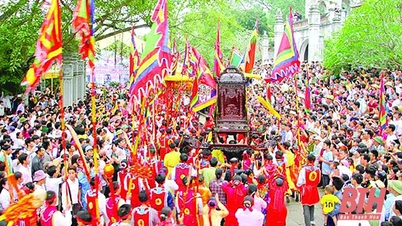On August 8, doctors at Ninh Binh Obstetrics and Pediatrics Hospital said they had just admitted a 3-year-old patient (residing in Hoa Lu ward, Ninh Binh) due to poisoning from Indian laurel leaves.

Emergency doctor treats 3-year-old child poisoned after drinking water from Indian laurel leaves (Photo: Phuong Phuong).
The family said that 5 days ago, the child had constipation. Believing in the folk remedy of using Indian laurel leaves, the family picked some leaves and boiled them in water for the child to drink.
After drinking, the baby's urine was dark red, increasing, the body was tired, vomiting, jaundice all over the body, so the family took the baby to the doctor. At Ninh Binh Obstetrics and Pediatrics Hospital, the baby was diagnosed with severe anemia, acute hemolysis after eating Indian laurel leaves, and G6PD deficiency.
Dr. Truong Cong Thanh, Head of the Emergency Department (Ninh Binh Obstetrics and Pediatrics Hospital) said that G6PD enzyme is produced by red blood cell membranes in the blood. People with G6PD enzyme deficiency, when eating Indian laurel leaves (which contain an agent that causes acute hemolysis), will lead to acute anemia, damage to the liver, kidneys and other organs, if not treated promptly, will be life-threatening.

After being given first aid, the baby's health gradually stabilized (Photo: Phuong Phuong).
Doctor Thanh added that at the hospital, the child was given a blood transfusion, corticosteroids, and hemodynamic monitoring. After 2 days of treatment, the child was less tired, had pink skin and mucous membranes, no jaundice, reddish-orange urine, and was eating and playing well.
Doctors also recommend that people should not arbitrarily use Indian laurel leaves or other leaves to treat diseases based on folk experience without any basis, especially children diagnosed with G6PD deficiency.
The leaves of the Indian laurel tree, or in some places called “every leaf”, are the leaves of the Indian laurel tree, a tree about 2-3 meters tall that grows wild. Because it has a laxative effect when used in small doses and a cleansing effect when used in large doses, people in some places often tell each other to use this leaf to treat constipation, dysentery, etc. However, if used in large quantities, Indian laurel leaves can cause poisoning.
When there are signs of poisoning, the patient must be quickly taken to a medical facility for timely treatment.
Source: https://dantri.com.vn/suc-khoe/chua-tao-bon-bang-la-loc-mai-be-3-tuoi-phai-nhap-vien-cap-cuu-20250808144358795.htm


![[Photo] Prime Minister Pham Minh Chinh chairs a meeting of the Government Standing Committee to remove obstacles for projects.](https://vphoto.vietnam.vn/thumb/1200x675/vietnam/resource/IMAGE/2025/10/06/1759768638313_dsc-9023-jpg.webp)































































































Comment (0)